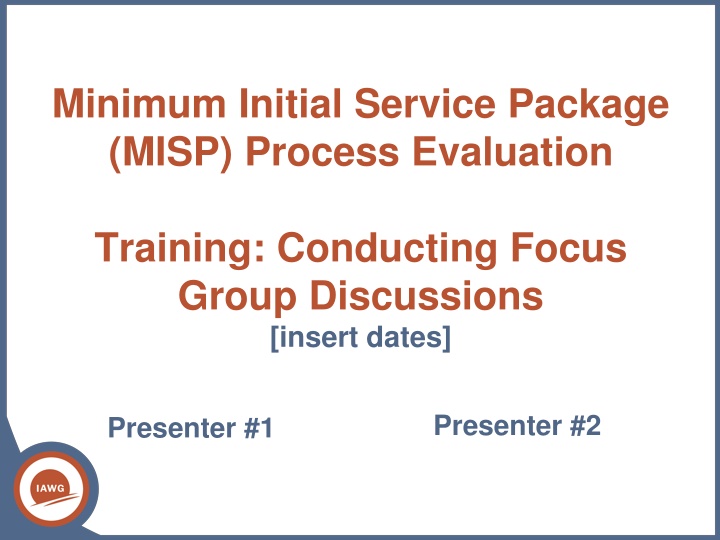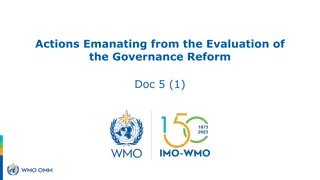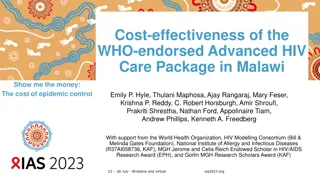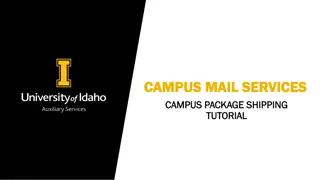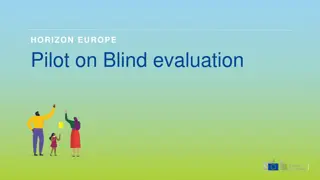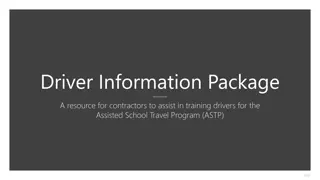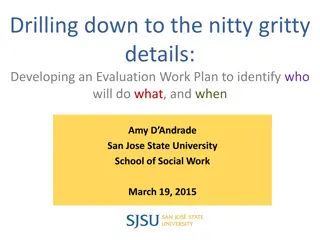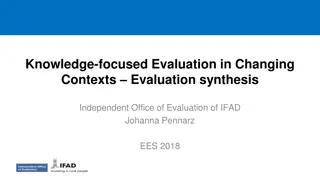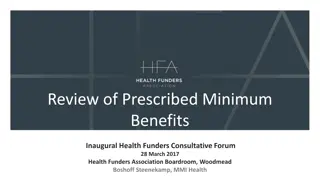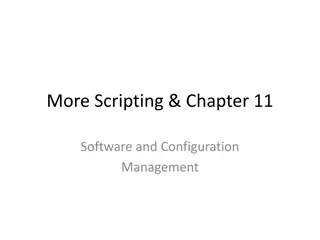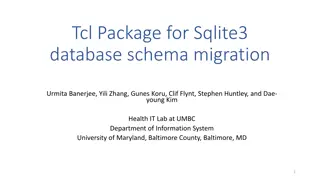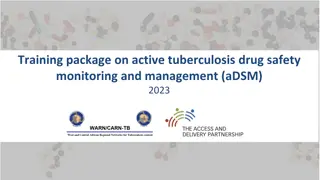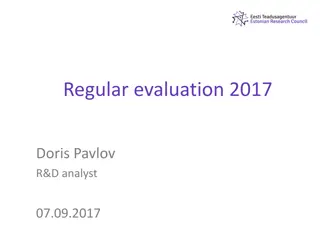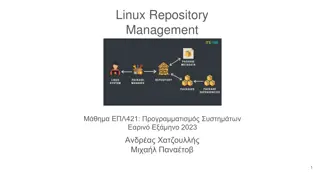Minimum Initial Service Package (MISP) Process Evaluation Training
Dive into the Minimum Initial Service Package (MISP) Process Evaluation Training that includes conducting focus group discussions, staff roles and responsibilities, overview of evaluation methodology, and ethical considerations. Explore agenda topics, introductions, team structures, roles, responsibilities, and timelines of activities. Understand communication protocols, security measures, administrative procedures, and participant recruitment planning for focus group discussions.
Download Presentation

Please find below an Image/Link to download the presentation.
The content on the website is provided AS IS for your information and personal use only. It may not be sold, licensed, or shared on other websites without obtaining consent from the author.If you encounter any issues during the download, it is possible that the publisher has removed the file from their server.
You are allowed to download the files provided on this website for personal or commercial use, subject to the condition that they are used lawfully. All files are the property of their respective owners.
The content on the website is provided AS IS for your information and personal use only. It may not be sold, licensed, or shared on other websites without obtaining consent from the author.
E N D
Presentation Transcript
Minimum Initial Service Package (MISP) Process Evaluation Training: Conducting Focus Group Discussions [insert dates] Presenter #2 Presenter #1
Agenda Day 1: Training Introductions Staff roles and responsibilities MISP overview Evaluation methodology overview Ethical issues and safety protocols Overview of focus group discussions (FGDs) Day 2: Training Introduction to FGD tools Practice, practice, practice Day 3: Pilot Conduct one male and one female FGD Practice translation/ transcription Debrief
Introductions What is your name? Where are you from? What are your favorite activities to do? What is your research experience? Experience in qualitative research Experience in sexual and reproductive health research or other work
Staff Roles and Responsibilities
Structure of Evaluation Team (Example) Site 1: [name] 1 Male Facilitator and 2 Male Notetakers 1 Female Facilitator and 2 Female Notetakers Site 2: [name] 1 Male Facilitator and 2 Male Notetakers 1 Female Facilitator and 2 Female Notetakers
Roles & Responsibilities of Teams Responsibilities Roles Facilitator Notetakers (1-2) Interpreter, if applicable (1) Timeliness Respect Be prepared Team player Ask questions!
Timeline of Activities (Example) Sunday Monday Tuesday Wednesday Thursday Friday Saturday Training Training Pilot Data Collection Day #1 Data Collection Day #2 Data Collection Day #3 Data Collection Day #4 Data Collection Day #5 Debrief Day among evaluation teams Debrief with stake- holders
Communication Protocol Security issues Administration Hours and lateness Housekeeping issues
Planning FGD Schedule and Participant Recruitment List of health workers How to recruit participants and informed consent Selecting the right environment/setting Scheduling dates/times for your FGDs
Sexual and Reproductive Health (SRH) in Humanitarian Settings WHY do we need to pay attention to SRH in a crisis? 66% of preventable maternal deaths & 45% of newborn deaths occur in countries affected by recent conflict, natural disaster or both 4% of population is pregnant at any time: 5-15% of all deliveries may require a cesarean section 9-15% of newborns will need live-saving emergency care Persons affected by humanitarian emergencies are highly vulnerable to life-threatening SRH conditions
Reproductive Health in Humanitarian Settings How does crisis worsen reproductive health? Destruction of health facilities Lack of trained staff Overwhelmed health facilities Breakdown of social structures, families Lack of supplies No access (displacement, security, cultural restrictions, knowledge/attitudes towards health care, economics) Targeted and opportunistic sexual violence Sexual exploitation
What is the Minimum Initial Service Package (MISP) for Sexual and Reproductive Health (SRH)? Minimum: Ensure basic, limited SRH services Initial: For use in emergencies, without a site-specific needs assessment Service: Health care for the population Package: Activities, supplies, coordination, and planning
Objective 1: Ensure the health sector/ cluster identifies an organization to lead implementation of the MISP Health sector/cluster identifies a lead SRH organization Lead SRH organization puts in place the SRH Coordinator who functions within the health sector/cluster Provide guidance on and technical support for the coordinated procurement of SRH supplies Identify skilled health workers to implement MISP services Identify effective and confidential referral mechanisms between health service delivery points and between health services and other service sectors
Objective 2: Prevent sexual violence and respond to the needs of survivors Establish preventative measures at community, local and district levels including health facilities to protect affected populations from sexual violence Make clinical care and referral to other supportive services available for survivors of sexual violence Ensure confidential and safe spaces within the health facilities to receive and provide survivors of sexual violence with appropriate clinical care and referral
Objective 3: Prevent the transmission of and reduce morbidity and mortality due to HIV and other STIs (1/2) Establish safe and rational use of blood transfusion Ensure application of standard precautions Guarantee the availability of free lubricated male condoms and, where applicable, ensure provision of female condoms Support the provision of antiretrovirals (ARVs) to continue treatment for people living with HIV
Objective 3: Prevent the transmission of and reduce morbidity and mortality due to HIV and other STIs (2/2) Provide post-exposure prophylaxis (PEP) to survivors of sexual violence and for occupational exposure Support the provision of co-trimoxazole prophylaxis for opportunistic infections for patients found to have HIV or already diagnosed with HIV Ensure the availability in health facilities of syndromic diagnosis and treatment of STIs
Objective 4: Prevent excess maternal and newborn morbidity and mortality Ensure availability and accessibility of clean and safe delivery, essential newborn care, and emergency obstetric and newborn care (EmONC) services Establish a 24 hour per day, 7 days per week referral system to facilitate transport and communication from the community to the health center and hospital Ensure availability of post-abortion care in health centers and hospitals Ensure availability of supplies and commodities for clean delivery and immediate newborn care where access to a health facility is not possible or is unreliable
Objective 5: Prevent unintended pregnancies Ensure availability of a range of long-acting reversible and short-acting contraceptive methods Provide information and, as soon as possible, ensure contraceptive counseling that emphasizes informed choice, effectiveness, and supports client privacy and confidentiality Ensure the community is aware of the availability of contraceptives for women, adolescents, and men
Objective 6: Plan for comprehensive SRH services integrated into primary health care as soon as possible Work with the health sector / cluster partners to address the six health system building blocks Service delivery Health workforce Health information system Medical commodities Financing Governance and leadership
Other MISP Priority It is also important to ensure that safe abortion care is available to the full extent of the law, in health centers and hospital facilities
Evaluation Methodology Case study design Site A Site B Purposive sampling Population Program staff Health workers Community members Methods Desk review KI Questionnaires Health facility assessments FGDs Method Sampling plan Data collection strategy Key informant (KI) Questionnaires Program managers and staff Semi- structured interviews Health facility assessments Sample of health facilities Structured questionnaire Focus group discussions (FGD) Sample of community members Open-ended questions
MISP Process Evaluation: FGDs Purpose of focus group discussions (FGD) Assess the extent that the MISP has been implemented in [insert country] since [insert emergency/date] FGD objectives Understand the main SRH concerns among crisis- affected communities Explore crisis-affected community knowledge and perceptions of MISP services Gain insight on the availability of MISP services Explore factors that influence the accessibility of MISP services
Focus Group Discussions Group composition: no more than 10 participants per group Site A Sub- group A Site B Sub- group A TOTAL No. of FGDs across all sites 8 8 8 8 32 Sub- group B Sub- group B Age-Gender Group Girls Boys Women Men 2 2 2 2 2 2 2 2 2 2 2 2 2 2 2 2
Evaluation Collaborators Evaluation Team Partner A Partner B, etc. Evaluation Partners UN agencies Reproductive Health Sub-Working Group Health Cluster, etc.
Evaluation Outcomes Share findings with evaluation partners to inform the development of program and policy recommendations Improve SRH services for people affected by the emergency Disseminate final reports (beneficiary, summary, full) in local languages and adapted for accessibility in local and international learning Inform future emergencies by ensuring quality SRH services are provided to affected populations in similar contexts
Ethical Issues and Safety Protocols
Principles of Ethical Research Respect integrity & minimize harm Informed consent Confidentiality Privacy Secure handling of data Sharing results with relevant stakeholders Understand the referral pathway for gender-based violence
Elements of Consent *If non-literate, read slowly in appropriate language and ask for questions Introduction Purpose of study Procedures Risks & benefits Questions or concerns Confidentiality Voluntary participation
Practice: Informed Consent Read out loud Identify consent elements: Purpose of study Procedures Risks and benefits Questions or concerns Confidentiality Voluntary participation
Eligible FGD Participants 18 and older regular consent 15 to 17 years: must meet one of these Ever married Pregnant Parent of a child
Overview of Focus Group Discussions
Quantitative vs. Qualitative Research Qualitative: Attempts to explain Complex, changing ( fluid ) Describes meanings: Perceptions, knowledge, beliefs, behaviors Describe variation Behaviors explained in context of what is happening around them Quantitative: Attempts to measure Often can quantify an event but NOT explain why it occurred Standardized so that larger generalizations can be made
Qualitative What happens in a house, how is a home defined, what influences what people do in their houses?
What Is Qualitative Research? Qualitative research is flexible Non-leading questions and statements are used Information is probed as much as possible Participants are treated as the expert The participants lead the conversation while staying on topic How and why things happen are of most interest The words people use are analyzed Research. Rethink. Resolve.
No right or wrong we are trying to understand perceptions
What Is a Focus Group Discussion? A group interview that emphasizes communication among group members in order to generate information about a chosen topic
Why Do Focus Groups? To collect information about knowledge, behaviors, what people think, how they think, and why they think that way To discover variety within a homogenous population To assess areas of agreement and disagreement between groups To develop a consensus view on a product To empower participants, to hear their voices *FGDs: NOT a way to interview a number of people at once
Roles In a FGD Facilitator - conducts the group interview Must be able to ask and clarify a question Hear the response Determine if further clarity is needed regarding the responses Notetaker - records what is being said or expressed Responsible for ensuring detailed documentation of the FG Back-up to recording device Captures quotes and who is speaking Retain specific terms or phrases in local language Record body language and nonverbal signals of participants Remind facilitator of issues overlooked during the discussion Both positions need to work together
The Facilitator Research. Rethink. Resolve.
What Are Characteristics of Good Facilitators? Language and communication skills Familiarity with the content and structure of the activity Familiarity and comfort level with discussing reproductive health topics Ability to respect the dignity and confidentiality of participants Previous experience conducting focus groups or other qualitative activities Ability to multi-task and be flexible with adjusting questions as needed
Steps for Conducting a FGD (1/3) 1. Prepare materials for FGD 2. Greet participants 3. Introduce yourself and the team Explain purpose of interview Describe link to local partners 4. Conduct informed consent Cannot promise other participants of the FGD will not share Encourage FGD participants not to reveal identities Avoid using participants names during the FGD If participants refuse to participate, thank them for their time and they can be excused from the group at any time
Steps for Conducting a FGD (2/3) 5. Give a few brief group rules One speaker at a time No side conversations Everyone participating, no one dominating 6. Move to first specific topic Thank you. Let s start with our first topic. One thing I ve heard several people mention is _____. What else can you say about that? or I m surprised no one has mentioned ____. Does it matter or not? Track connection between conversation and guide
